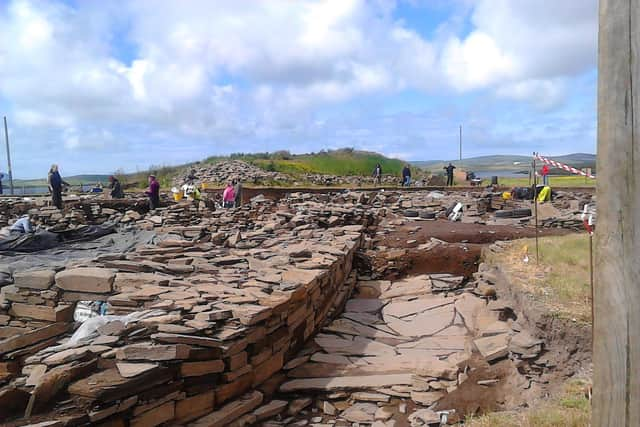Potter's fingerprint left behind on 5,000-year-old piece of clay in 'poignant' Orkney discovery


The fingerprint was pressed on a clay sherd recovered from the massive Ness of Brodgar complex of monumental buildings on the mainland.
It is the latest discovery made during the long-running excavation of the Neolithic site by the Archaeology Institute at the University of the Highlands and Islands.
Advertisement
Hide AdAdvertisement
Hide AdNick Card, excavation director, said: “Working on such as high-status site as the Ness of Brodgar, with its beautiful buildings and stunning range of artefacts, it can be all too easy to forget about the people behind this incredible complex.


"But this discovery really does bring these people back into focus.
“Although finding the fingerprint impression won’t hugely impact our work, it does give us a highlypersonal, poignant connection to the people of Neolithic Orkney, 5,000 years ago.”
The potter’s fingerprint was noted by ceramics specialist Roy Towers, who was examining a pot sherd from the huge assemblage recovered from the site – the largest collection of late Neolithic Grooved Ware pottery in the UK.
Reflectance Transformation Imaging (RTI) was used to confirm the suspected print, with multiple photographs taken of a subject, each with a different, but controlled, light source.
These are combined to create a highly detailed model of the object that can be lit from all angles and closely examined on screen. The end images often reveal surface details not visible during normal examination.
As a result of this work, Jan Blatchford of the Archaeology Institute confirmed and recorded the only fingerprint encountered at the Ness of Brodgar.
Given the widespread use of clay in prehistory, ancient fingerprints are not uncommon.
Advertisement
Hide AdAdvertisement
Hide AdIt is now hoped the print will become a gateway to more information about the potter and establish if the maker was male or female, and perhaps their age.
The vast Ness of Brodgar site has been described as a cathedral of its day with only a portion of the original site thought to have been uncovered.
It sits in the Heart of Neolithic Orkney World Heritage Site and forms part of a rich landscape that flourished as a ‘new world order’ took shape on the islands.
The Neolithic period began in Scotland around 4,000BC with the arrival of immigrant farmers from north-western and northern France.
Some settled around the Oban area while others arrived on the east coast and rapidly spread westwards. Expansion to the Outer Hebrides, Shetland and Orkney followed.
By around 3,500 BC, prosperous farmers in northern Scotland and Orkney were vying with each other to build bigger and grander monuments for their dead.
In Orkney, where the farmers fared well from their cattle herds, this process culminated in a series of “momentous social and ideological developments” between 3,300 and 2,800 BC with a “New World Order” being established on the islands.
A new style of monument, the Stones of Stenness stone circle and henge, were built and a new style of pottery called Grooved Ware created. Enormous houses at the huge site at Ness of Brodgar appeared.
